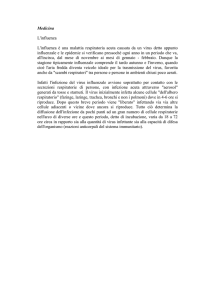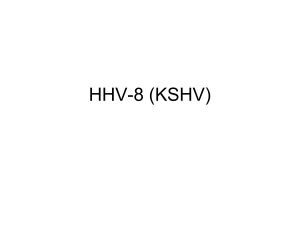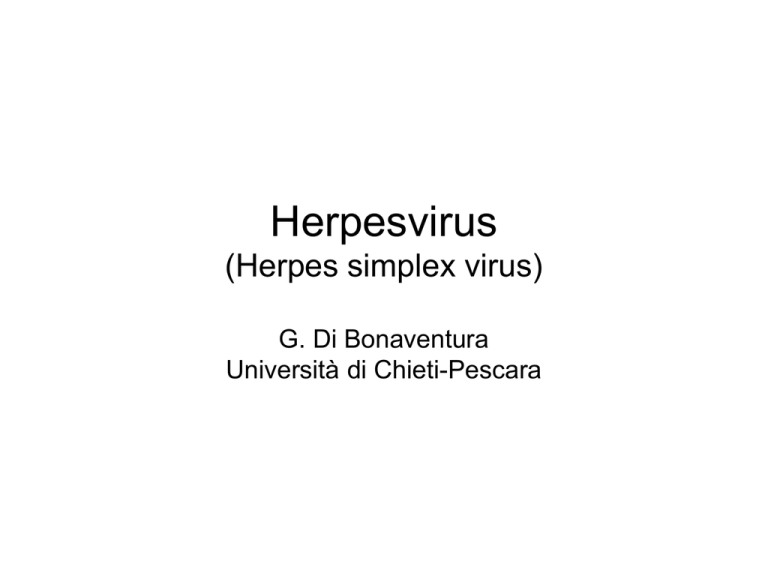
Herpesvirus
(Herpes simplex virus)
G. Di Bonaventura
Università di Chieti-Pescara
Proprietà caratteristiche degli herpesvirus
From Medical Microbiology, 4th ed., Murray, Rosenthal, Kobayashi & Pfaller, Mosby Inc., 2002, Table 51-1.
Alphaherpesvirinae: ampio spettro d’ospite (inoculazione per scarificazione o per via
intracerebrale), si replicano in diversi tipi di colture cellulari
Gammaherpesvirinae: specie-specifici, si replicano solo in colture cellulari della specie sensibile
Betaherpesvirinae: ristretto spettro d’ospite, tropismo per le cellule linfoidi
Herpesvirus: struttura
Herpes Simplex Virus-1: capside, SEM
Cryomicroscopy. Z. H. Zhou, B.V.V Prasad, J.
Jakana, F.R. Rixon, W. Chiu Baylor College of
Medicine, Journal of Molecular Biology
Human herpesvirus 3 (varicella-zoster virus 1) Capsidi
con envelope ed envelopes vuoti. Dr Frank Fenner,
John Curtin School of Medical Research, Australian
National University, Canberra, Australia.
Virione: tondeggiante, 200 nm
Peplos
Tegumento (matrice): proteine virus-specifiche
Capsìde icosaedrico: 100 nm, 162 capsomeri
Nucleoide: struttura a rocchetto con avvolto il DNA
Genoma: DNA ds, lineare
Herpesvirus: genoma
Herpesvirus genomes. The genomes of the herpesvirus are doubled-stranded DNA. The length and complexity of the genome differ for each
virus. Inverted repeats in herpes simplex virus (HSV), varicella-zoster virus (VZV), and cytomegalovirus (CMV) allow the genome to recombine
with itself to form isomers. Large genetic repeat sequences are boxed. The genomes of HSV and CMV have two sections, the unique long (UL )
and the unique short (US ), each of which is bracketed by two sets of inverted repeats of DNA. The inverted repeats facilitate the replication of
the genome but also allow the UL and US regions to invert independently of each other to yield four different genomic configurations, or isomers.
VZV has only one set of inverted repeats and can form two isomers. Epstein-Barr virus (EBV) exists in only one configuration, with several
unique regions surrounded by direct repeats. Purple indicates direct repeat DNA sequences; green indicates inverted repeated DNA sequences.
HHV6=human herpesvirus 6. From Medical Microbiology, 4th ed., Murray, Rosenthal, Kobayashi & Pfaller, Mosby Inc., 2002, Table 51-2.
Herpesvirus: ciclo replicativo
Diagram of the replication cycle of HSV. At the upper left, the virion binds to the cell plasma membrane, and the virion envelope fuses with the
plasma membrane, releasing the capsid and tegument proteins into the cytoplasm. The vhs protein acts to cause degradation of mRNAs. The
capsid is transported to the nuclear pore, where the viral DNA is released into the nucleus. The viral DNA circularizes and is transcribed by host
RNA polymerase II to give first the IE or a mRNAs. IE gene transcription is stimulated by the VP16 tegument protein. Five of the six IE proteins
act to regulate viral gene expression in the nucleus. They transactivate E or b gene transcription. The E proteins are involved in replicating the
viral DNA molecule. Viral DNA synthesis stimulates L or g gene expression. The L proteins are involved in assembling the capsid in the nucleus
and modifying the membranes for virion formation. The filled capsid buds through the inner membrane to form an enveloped virion, and the virion
exits from the cell by mechanisms described in the section on Virion Assembly and Egress. (From Fields Virology, 4th ed, Knipe & Howley, eds,
Lippincott Williams & Wilkins, 2001, Fig. 72-3)
Herpesvirus: maturazione degli involucri virali
Figure 72-10 Diagram of pathways of egress. HSV capsids bud through the inner nuclear membrane, forming an enveloped virion particle.
Egress of the virions from the host cell may occur by either of two general pathways. A: The envelope fuses with the outer nuclear membrane,
de-enveloping the capsid and releasing it into the cytoplasm. The capsid then buds into the Golgi apparatus, forming an enveloped virion,
which is transported to the surface by vesicular transport. B: The virion particle buds through the outer nuclear membrane and is transported
by vesicular movement through the Golgi apparatus to the exterior of the cell. (From Fields Virology, 4th ed, Knipe & Howley, eds, Lippincott
Williams & Wilkins, 2001, Fig. 72-10)
Herpes-Simplex Virus (HSV)
Ciclo biologico: Latenza
Dalla sede di infezione primaria HSV migra, per via nervosa/ematica, verso i gangli nervosi dorsali sensitivi
(HSV1: gangli trigeminali; HSV2: gangli sacrali), sede dell’infezione latente.
Durante la latenza, il DNA virale si trova nel neurone in forma circolare ed episomale. Esso non viene
trascritto, ad eccezione del LAT (Latency-Associated Transcript) presente a livello nucleare.
In presenza di opportuni stimoli locali (traumi) o generali (stress emotivi, fisici od ormonali), l’infezione si
“riattiva” con replicazione virale e progressione verso la sede di impianto primaria.
La frequenza e la gravità delle “riattivazioni” dipendono dal numero di neuroni infettati e dalla
immunocompetenza dell’ospite.
I virus “riattivati” infettano altri neuroni, consentendo così la persistenza dell’infezione (lifelong).
Herpes-Simplex Virus (HSV)
HSV-1: malattia
Contagio interumano (soprattutto nella prima infanzia): saliva, posate, bicchieri.
Causa lesioni vescicolari confluenti (a “grappolo”) a localizzazione periorale cutanea (erpete labiale) e/o
nella mucosa orale (gengivo-stomatite).
L’infezione può essere asintomatica.
Occasionalmente, HSV-1 può infettare la congiuntiva e la cornea (autoinoculazione), causando
cheratocongiuntivite con compromissione della funzionalità visiva.
Raramente, diffonde all’encefalo, causando encefalite necrotico-emorragica.
Può causare lesioni a livello genitale (il sito di infezione non è predittivo del tipo di HSV)
Herpes-Simplex Virus (HSV)
HSV-2: malattia
Contagio interumano (età adulta): via sessuale.
Il virus attraversa la cute/mucosa attraverso lesioni e si replica nella sede di penetrazione iniziale.
Il contagio del neonato attraverso il canale del parto può causare estese infezioni erpetiche, infezioni
oculari, encefaliti, meningiti.
Le lesioni cutanee/mucose hanno caratteristiche similari a quelle causate da HSV-1.
L’infezione può essere asintomatica.
Può causare lesioni nella regione periorale ed orale (il sito di infezione non è predittivo del tipo di HSV).
Herpes-Simplex Virus (HSV)
Diagnosi
Isolamento virale in colture cellulari a partire dal liquido delle vescicole
cutanee, da materiale proveniente dal raschiamento delle ulcere corneali
(strisci di Tzanck) o da liquor.
Caratteristico effetto citopatico: presenza di cellule multinucleate giganti
con corpi inclusi intranucleari (corpi di Cowdry di tipo A)
L’identificazione definitiva avviene mediante:
a) dimostrazione antigeni virale immunofluorescenza, direttamente sul
materiale patologico o sulle colture infettate con il campione clinico,
mediante l’impiego di Abs monoclonali anti-HSV1 e anti-HSV2.
b) dimostrazione del DNA virale (PCR)
La ricerca sierologica è priva di significato, sia per l’elevato livello di Abs in
pazienti asintomatici che per la diffusione dell’infezione nella popolazione.

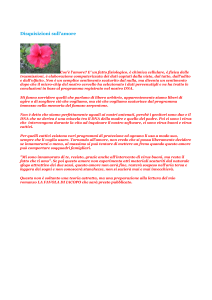
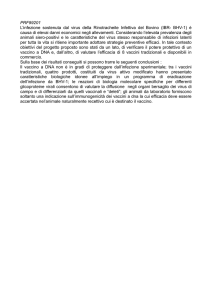
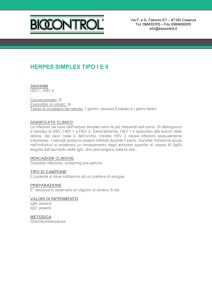
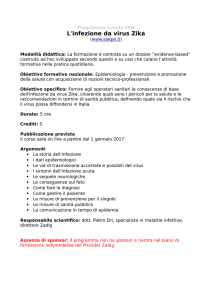

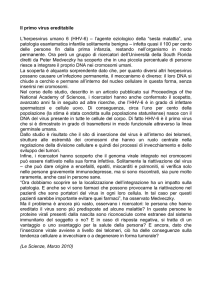
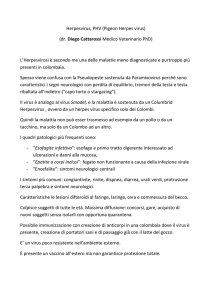
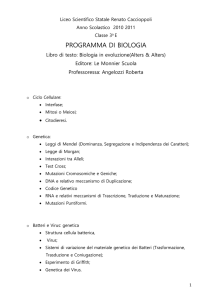
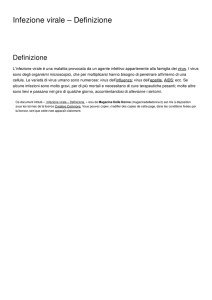
![Lezione 15 Virus [modalità compatibilità]](http://s1.studylibit.com/store/data/000771737_1-84b1cca561c5813066d1b76125338a98-300x300.png)
